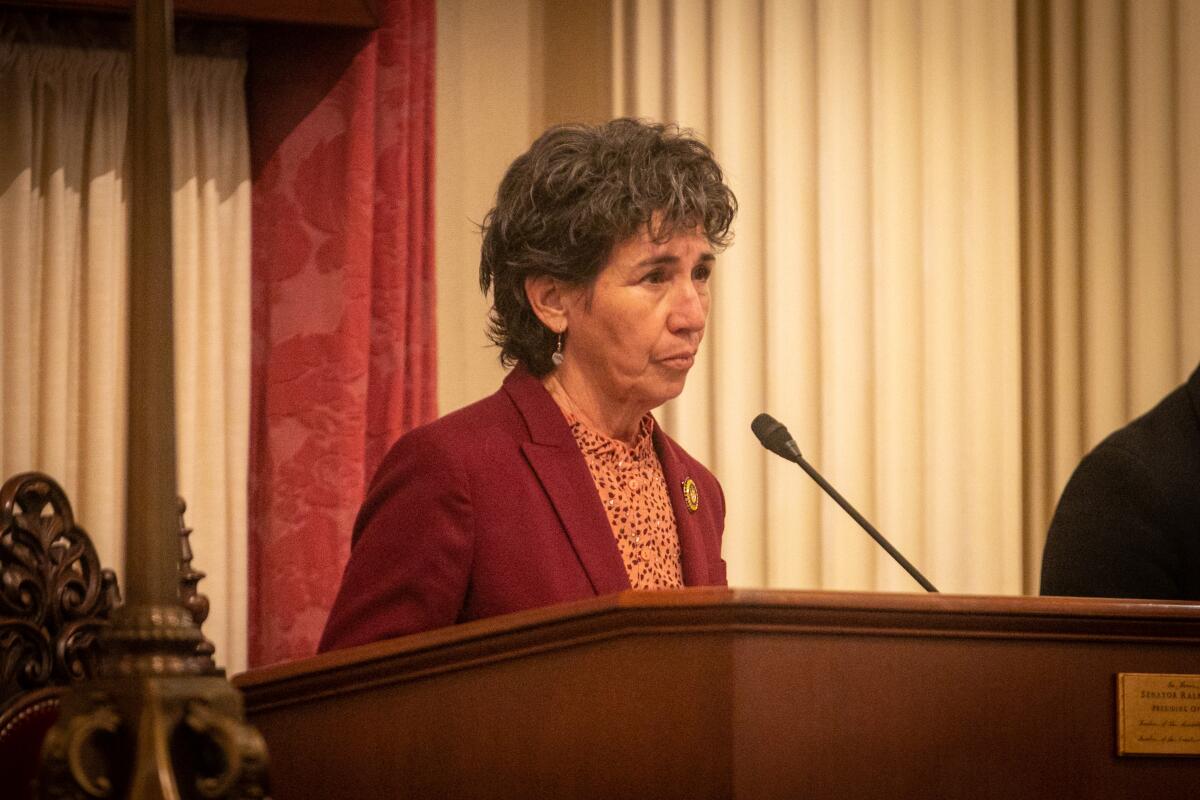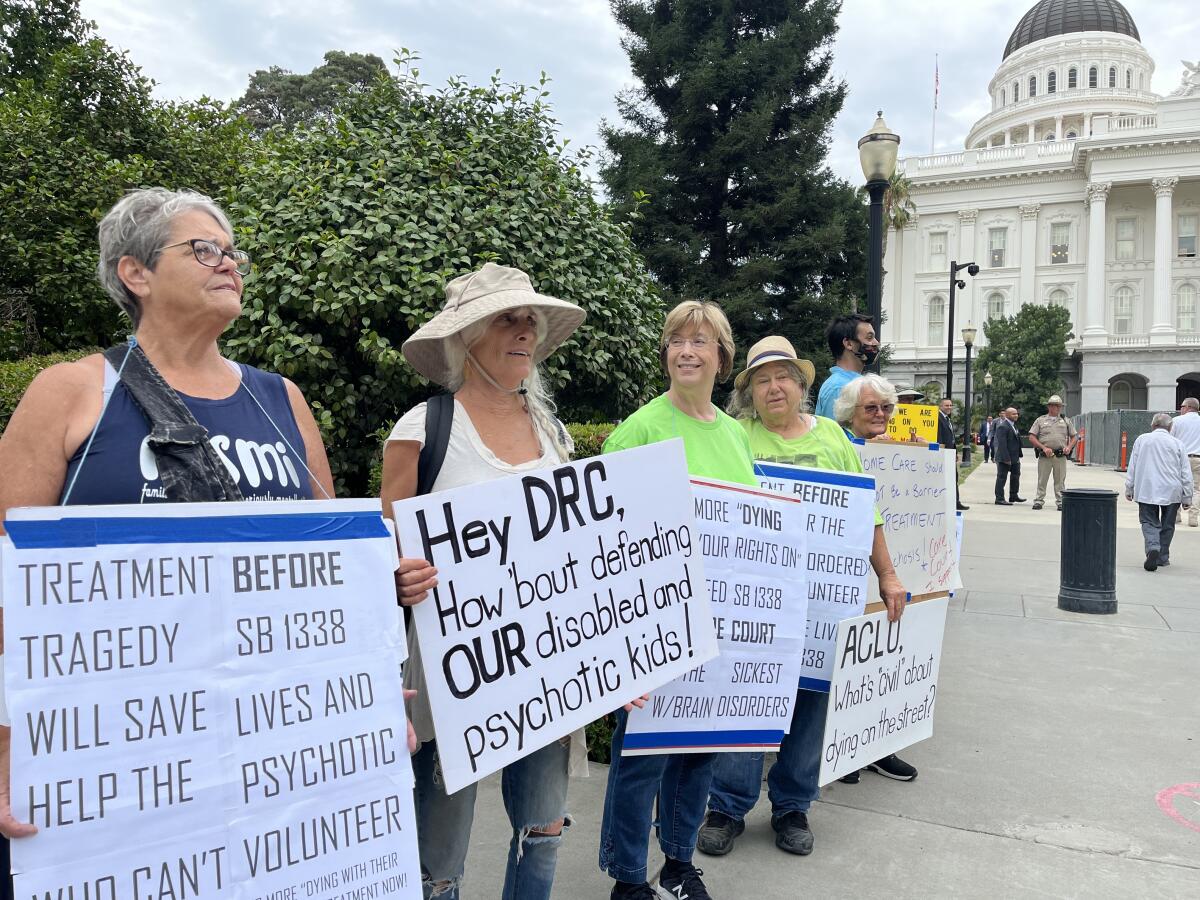‘Against their will’: A proposed law would make it easier to detain people with mental illness

- Share via
When lawmakers, mayors, psychiatrists and mental health advocates gathered last month to unveil a bill that would “enact major changes to California’s behavioral health law,” they put into motion an annual ritual in Sacramento.
Updating the Lanterman-Petris-Short Act has long been the goal of critics who say the landmark 1967 law has become an impediment to providing mental health treatment for those most in need.
The author of the newest effort is state Sen. Susan Talamantes Eggman (D-Stockton), and her bill — SB 43 — arrives at a time when untreated mental illness is both a heartache and a frustration for families and communities throughout the state.
Eggman’s bill would expand the criteria by which people in extreme psychological distress can be detained against their will by police, crisis teams and mental health providers. It is among recent attempts by lawmakers to make it easier to help individuals, many of them homeless, who are suffering from potentially life-threatening psychoses.
“The amount of work we have done since 2020 is huge, but it has not made a huge dent in helping the most ill,” Eggman said in an interview. “We can’t do it all through voluntary care. We need the full continuum of care — from prevention to early intervention, all the way to conservatorships — so the sickest of people don’t fall through the cracks and splatter on the sidewalks.”
Eggman’s commitment to the bill, which includes a provision that makes it easier for medical records to be used in conservancy hearings, is informed by her experience as a social worker and seeing firsthand the outcomes of untreated mental illness. Last year, she introduced similar legislation — SB 1416 — that failed to get through the Assembly Judiciary Committee.
She says SB 43 is even more ambitious.
“If we’re going to fix a broken law, then we’re going to go all the way,” she said.
Previous efforts to amend the LPS Act have failed amid opposition from disability and civil rights advocates who argue that changes to the law violate equal protection rights under the state Constitution. They have expressed similar concerns about SB 43.
Calling the bill “overly broad” and an “unprecedented” expansion of involuntary treatment and conservatorship, a nonprofit group representing behavioral health directors argues that SB 43 “would further stigmatize behavioral health conditions and frustrate our clients and the public.”
Disability Rights California, which advocates for people with disabilities, has denounced the bill as “highly speculative,” saying it would lead to more people being deprived “of fundamental rights and liberty.”
The language of SB 43 will undoubtedly change in the months ahead. Last month, the Senate Health Committee made a few recommendations, and later this month, the Senate Judiciary Committee will conduct its own analysis.
The process can lead to a “death by a thousand cuts,” said Dr. Roderick Shaner, former medical director of the Los Angeles County Department of Mental Health. “It’s difficult to categorically oppose a bill like this when the suffering of people with untreated severe mental illness is so apparent. So instead, you continue to narrow the language of the bill so that in the end it is rendered ineffective.”
Eggman is determined not to let that happen.
“I will not deliver something that is so watered down that it will do no good,” she said, optimistic that her work will benefit from the momentum of other related initiatives.

In March, Gov. Gavin Newsom announced plans for a $3-billion bond measure for the construction of mental health campuses, residences and permanent supportive housing. He also proposed reallocating $1 billion from a special mental health funding initiative to operate the facilities.
This push comes as eight California counties work to put the CARE Act in place by fall. That legislation, currently being challenged by Disability Rights California and other groups, will create special judicial courts designed to increase pressure on individuals with the hardest-to-treat behavioral conditions.
Though SB 43 is still in its formative legislative stage, it is a guidepost for understanding the ethical and philosophical implications of bringing mental health treatment to those who resist it.
“We hear so much talk about balancing civil liberties against the need for treatment, as if they are trade-offs,” Shaner said. “We have to figure out how to provide for both. We can’t destroy personal liberty in the name of mental healthcare, or the other way around. We can’t have one without the other.”
‘Gravely disabled’
In its attempt almost 60 years ago to address severe mental health crises for those who need immediate assistance and treatment, the LPS Act laid out three conditions for detaining someone against their will. An individual needs to be a “danger to self,” a “danger to others” or “gravely disabled.”
Eggman and her coauthors have targeted their effort on that singular phrase “gravely disabled.”
So what does it mean?
The authors of LPS defined “gravely disabled” as the inability to provide for the most essential aspects of life — food, clothing or shelter — or being “mentally incompetent.”
Some argue that this definition today is too narrow and that an individual living in a doorway and subsisting on donations of meals and clothing might not be considered gravely disabled.
SB 43 would change that. The legislation preserves the original 1967 definition but adds a new set of criteria that will be carefully analyzed and debated in the weeks ahead — a little more than 200 words that likely will determine its fate.
Unlike the old definition, which looked specifically at existing circumstances, such as the inability to provide for food, clothing and shelter, Eggman’s bill considers the “substantial risk” of “deterioration, debilitation or illness” for someone with a mental illness or substance use disorder if it is ignored or untreated.
But proposing legislation based on future outcomes is a challenge, according to Alex Barnard, assistant professor of sociology at New York University.
“This is saying that courts can determine whether you are gravely disabled based on a prediction that you will do something — or something will happen to you — that puts you at risk of harm,” he said, “and it is really hard to predict someone’s decline.”
This language raises the possibility of continued detention for those who get better under treatment but whose ability to care for themselves is still questioned, Barnard added.
SB 43 also adds “substance use disorder” as an indicator of grave disability, expanding on the LPS authors’ concern about the role that addiction plays in mental illness. Their focus in 1967 was on “chronic alcoholism”; one section of the law was titled “Detention of Inebriates for Evaluation and Treatment.”
By incorporating addiction to street drugs like methamphetamines, SB 43 has drawn pointed opposition from the County Behavioral Health Directors Assn., a nonprofit advocacy group.
In a letter to Eggman and the Senate Health Committee, Michelle Doty Cabrera, the group’s executive director, argued that “coerced and involuntary treatment” for substance abuse disorder is counterproductive and that effective outcomes arise from voluntary compliance.
In addition, Cabrera wrote, detaining and conserving individuals under such criteria “would constitute an enormous, gross overreach of the state’s power … [threatening] California’s progress addressing equity and disparities for Black, Latinx, Indigenous, LGBTQ+ and other historically marginalized populations.”
But Eggman says her bill does not take away from existing protections.
“We’re changing nothing in terms of due process, only the criteria that is applied,” she said.
Critics have also seized on a section of SB 43 that cites the inability to attend “to necessary personal or medical care” and “to self-protection or personal safety” as evidence of grave disability.
“What constitutes personal care?” asked Elyn Saks, a professor of law at USC. “And how do we distinguish mental illness from eccentricity or neurodiversity? Who makes that determination?”
Barnard has similar concerns: “How do you know whether it’s the environment or the person themselves that’s contributing to their vulnerability?”
The answers are not difficult, according to Eggman, who often cites examples of individuals she has seen in the streets and in hospitals who, without detention or treatment, are at risk of dying.
“James Mark Rippee died of an infection,” she said, referring to a homeless Bay Area man with schizophrenia whose death last year from pneumonia might have been prevented. Rippee had been the subject of numerous media reports for the efforts of his sisters to get him off the streets.
Perhaps SB 43’s most controversial interpretation of being gravely disabled is a person’s inability “to understand their disorder” and whose “decision making is impaired due to their lack of insight into their disorder.”

In a 2013 article in the Review of Law and Social Justice, Saks argued that denial of mental illness is not proof of a patient’s incompetency — that it can be “a rational attempt to avoid negative consequences,” such as the negative side effects associated with medications.
By including “lack of insight” without further definition, Shaner said, this provision of SB 43 runs the unnecessary risk of being seen as a “Kafkaesque” return to the pre-LPS days when the more a person protested against treatment, the more they seemed to demonstrate their illness.
“Insight is too easily mischaracterized as the extent that a patient agrees with the examiner,” he said.
A case against involuntary commitment
Eggman has described SB 43 as being specifically intended to provide treatment for individuals “against their will if need be.” Critics fear that the practice, however well-intentioned, could mean a return to the past.
Prior to LPS, involuntary commitment in California was as simple as a decision made by a psychiatrist, with no means for review or appeal. As a result, state mental hospitals were flooded with patients — 37,000 by 1955 — who languished in psychiatric wards. Many were poor and indigent and subjected to treatments that were misguided, unscientific and cruel.
LPS meant to change that practice by ending “the inappropriate, indefinite, and involuntary commitment of persons with mental health disorders, developmental disabilities, and chronic alcoholism, and to eliminate legal disabilities.”
The trauma of involuntary commitment for those with severe mental illness requires nothing less, Saks said.
“When we think about competency or capacity standards — and how we balance liberty and paternalism — I come down on the side of liberty,” she said. “I found it so toxic and painful to be treated involuntarily.”
In the 1980s, Saks was treated for a psychotic break related to schizophrenia while a student at Yale Law School. In her memoir, she recounts how a medical team examined her and decided to “bind both my legs and both my arms to the metal bed with thick leather straps.”
Coercion is counterproductive, Saks said.
“We can either increase the amount of involuntary care,” she said, “or we can help people so that they want to take care of themselves. We should try to talk to them in a way that is meaningful for them and makes them feel understood, not humiliated or degraded.”
Dr. Margot Kushel, who directs the Center for Vulnerable Populations at UC San Francisco, is similarly concerned that expanding the definition of “gravely disabled” might lead to biases that further erase the dignity and autonomy of those with disabilities. She wonders if the problem is less about the definition than about “our collective inability” to help people with severe mental illness receive the services and support they need.
“The bigger problem,” she said, “is we don’t have the right resources to allow people to live with the most independence. I suspect there isn’t any amount of tinkering with the definition that will get to the heart of that problem.”
Address the need for more psychiatric beds and staffing, she said — “then we can decide if we have the wrong definition.”
Is it constitutional?
As SB 43 makes its way through committees to floor votes in the Senate and the Assembly, the debate and challenges will undoubtedly become more fierce.
“If you thought the challenges to CARE Court were intense,” Barnard said, “well, this is much more coercive than that. Civil liberties groups will go ballistic.”
But the fate of the legislation ultimately will lie with the California Supreme Court, said former state Sen. Hannah-Beth Jackson. While serving as chair of the Senate Judiciary Committee until 2020, Jackson reviewed similar legislation that would amend LPS.
“Unless — and until — the California Supreme Court determines that expansion of the definition of ‘gravely disabled’ does not constitute a violation of the Equal Protection Clause or any interpretation of either the state or federal Constitutions, legislative changes to the definition are likely to be struck down as unconstitutional,” she said.
Still, Eggman is optimistic, pointing out that what’s at stake is more than just a legal battle. People are dying with their rights on, she frequently says.
“We might think that we live in an ideal world where everyone can take care of themselves,” she said. “But there are always going to be those among us who need extra help. We don’t live in an ideal world. To pretend otherwise is a travesty.”
More to Read
Sign up for Essential California
The most important California stories and recommendations in your inbox every morning.
You may occasionally receive promotional content from the Los Angeles Times.











